Semiconductor production equipment company Kulicke & Soffa (NASDAQ: KLIC) reported results in line with analysts' expectations in Q1 FY2024, with revenue down 2.9% year on year to $171.2 million. On the other hand, next quarter's revenue guidance of $170 million was less impressive, coming in 11.6% below analysts' estimates. It made a non-GAAP profit of $0.30 per share, down from its profit of $0.37 per share in the same quarter last year.
Kulicke and Soffa (KLIC) Q1 FY2024 Highlights:
- Market Capitalization: $2.98 billion
- Revenue: $171.2 million vs analyst estimates of $172 million (small miss)
- EPS (non-GAAP): $0.30 vs analyst estimates of $0.26 (16.3% beat)
- Revenue Guidance for Q2 2024 is $170 million at the midpoint, below analyst estimates of $192.3 million
- Free Cash Flow was -$11.76 million, down from $68.21 million in the previous quarter
- Inventory Days Outstanding: 236, up from 186 in the previous quarter
- Gross Margin (GAAP): 46.7%, down from 50.3% in the same quarter last year
Headquartered in Singapore, Kulicke & Soffa (NASDAQ: KLIC) is a provider of production equipment and tools used to assemble semiconductor devices
Kulicke & Soffa was founded in 1951 by Frederick Kulicke Jr. and Albert Soffa, and the company was incorporated in 1956. With a 1971 NASDAQ listing, Kulicke & Soffa became one of the first technology companies on the exchange.
The company’s key products are equipment and tools used in the interconnect processes of semiconductor manufacturing. The interconnect process is the wiring system that connects transistors and other components on a chip. This step in manufacturing is important because these connections can be a limiting factor to chip performance, as electrical resistance of wires increases as they are made smaller and thinner to accommodate more transistors.
KLIC’s products therefore aim to improve performance and increase power efficiency amid smaller form factors. One example is the company’s ball bonder, which enables precise electrical interconnections between a bare silicon die and the lead frame of the package it is placed in during semiconductor fabrication. Another example is the company’s wedge bonder, which uses ultrasonic power and force to form resilient bonds.
Competitors offering semiconductor equipment and packaging materials products include ASM Pacific Technology (SEHK:522), BE Semiconductor Industries (ENXTAM:BESI), and Hanwha Precision Machinery.Sales Growth
Kulicke and Soffa's revenue growth over the last three years has been strong, averaging 26.2% annually. But as you can see below, its revenue declined from $176.2 million in the same quarter last year to $171.2 million. Semiconductors are a cyclical industry, and long-term investors should be prepared for periods of high growth followed by periods of revenue contractions (which can sometimes offer opportune times to buy).
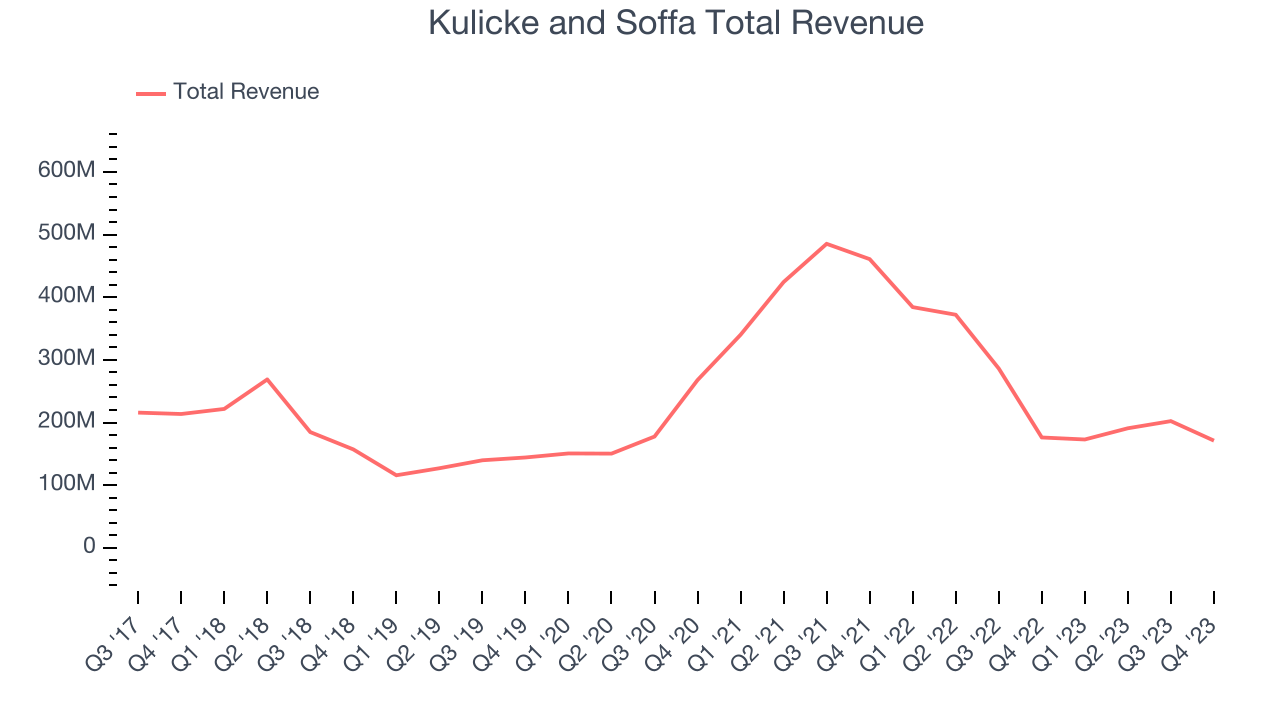
Kulicke and Soffa had a difficult quarter as revenue dropped 2.9% year on year, missing analysts' estimates by 0.5%. This could mean that the current downcycle is deepening.
Kulicke and Soffa may be headed for an upturn. Although the company is guiding for a year-on-year revenue decline of 1.7% next quarter, analysts are expecting revenue to grow 18% over the next 12 months.
Product Demand & Outstanding Inventory
Days Inventory Outstanding (DIO) is an important metric for chipmakers, as it reflects a business' capital intensity and the cyclical nature of semiconductor supply and demand. In a tight supply environment, inventories tend to be stable, allowing chipmakers to exert pricing power. Steadily increasing DIO can be a warning sign that demand is weak, and if inventories continue to rise, the company may have to downsize production.
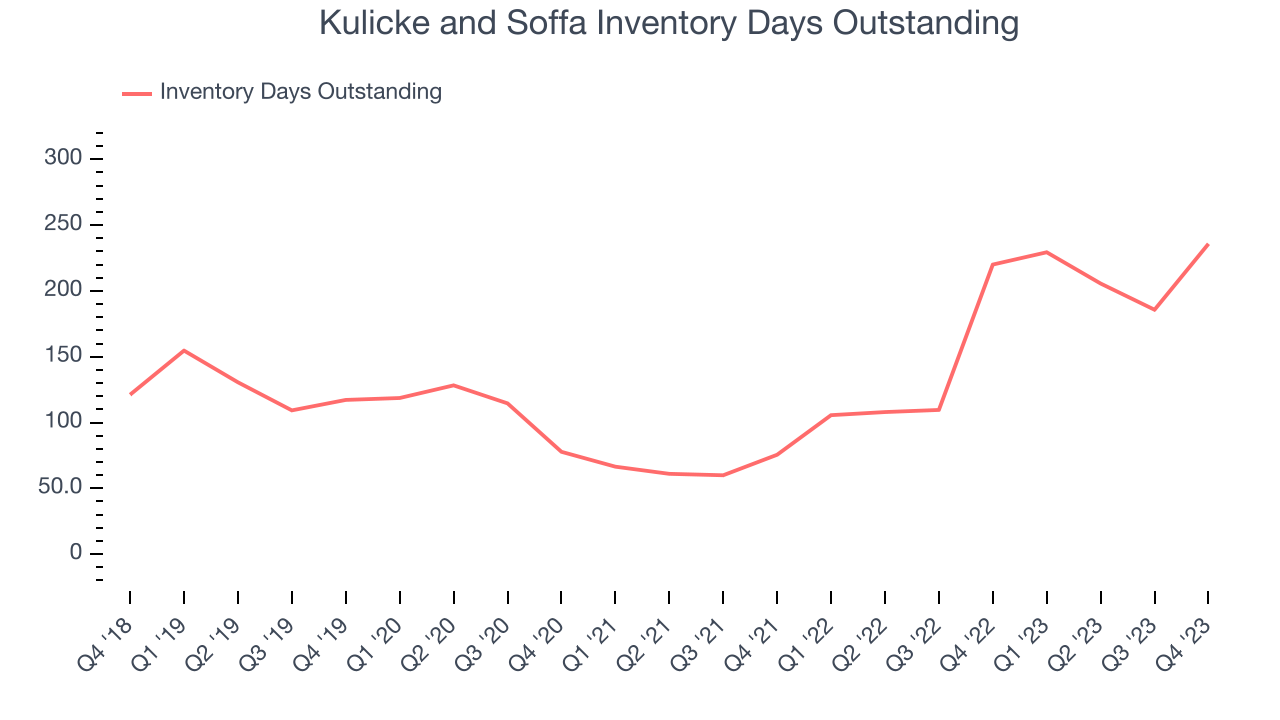
This quarter, Kulicke and Soffa's DIO came in at 236, which is 105 days above its five-year average, suggesting that the company's inventory has grown to higher levels than we've seen in the past.
Pricing Power
In the semiconductor industry, a company's gross profit margin is a critical metric to track because it sheds light on its pricing power, complexity of products, and ability to procure raw materials, equipment, and labor. Kulicke and Soffa's gross profit margin, which shows how much money the company gets to keep after paying key materials, input, and manufacturing costs, came in at 46.7% in Q1, down 3.7 percentage points year on year.
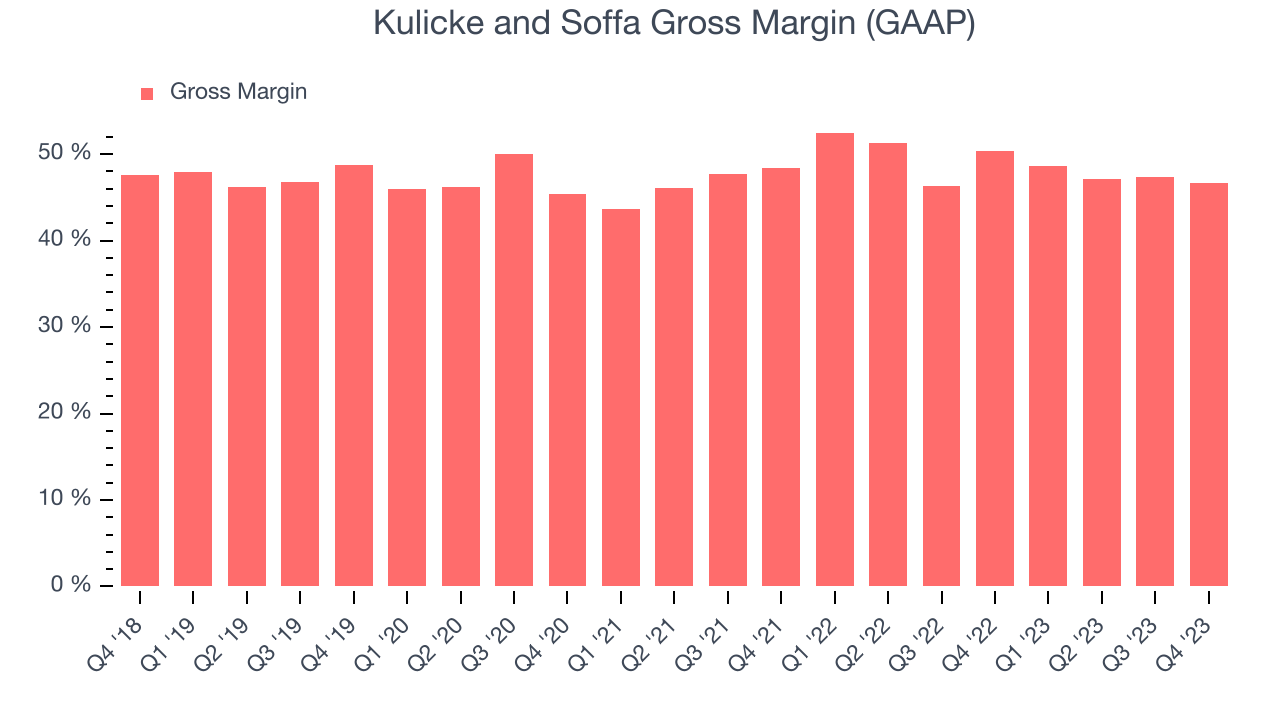
Kulicke and Soffa's gross margins have been trending down over the last 12 months, averaging 47.4%. This weakness isn't great as Kulicke and Soffa's margins are already slightly below the industry average and falling margins point to potentially deteriorating pricing power.
Profitability
Kulicke and Soffa reported an operating margin of 6.4% in Q1, down 5.1 percentage points year on year. Operating margins are one of the best measures of profitability because they tell us how much money a company takes home after manufacturing its products, marketing and selling them, and, importantly, keeping them relevant through research and development.
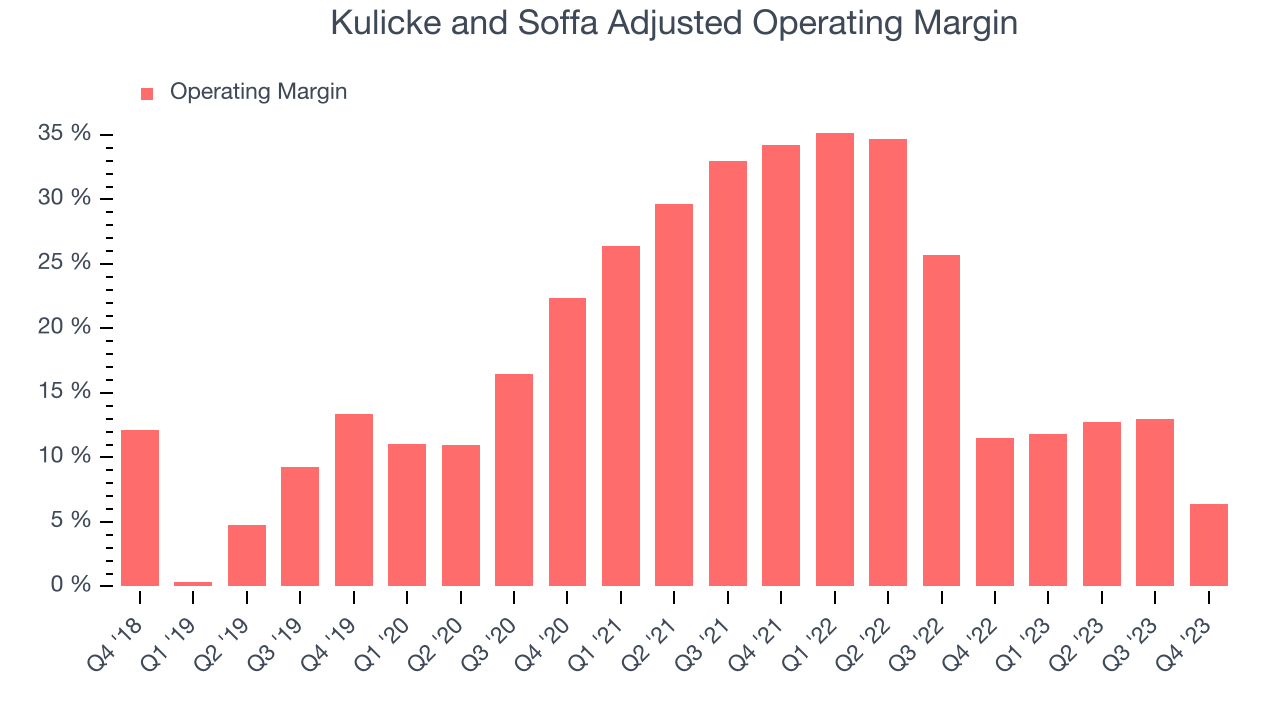
Kulicke and Soffa's operating margins have been trending down over the last year, averaging 11%. This is a bad sign for Kulicke and Soffa, whose margins are already below average for semiconductor companies. To its credit, however, the company's margins suggest modest pricing power and cost controls.
Earnings, Cash & Competitive Moat
Analysts covering Kulicke and Soffa expect earnings per share to grow 33.9% over the next 12 months, although estimates will likely change after earnings.
Although earnings are important, we believe cash is king because you can't use accounting profits to pay the bills. Kulicke and Soffa's free cash flow came in at negative $11.76 million in Q1, down 117% year on year.
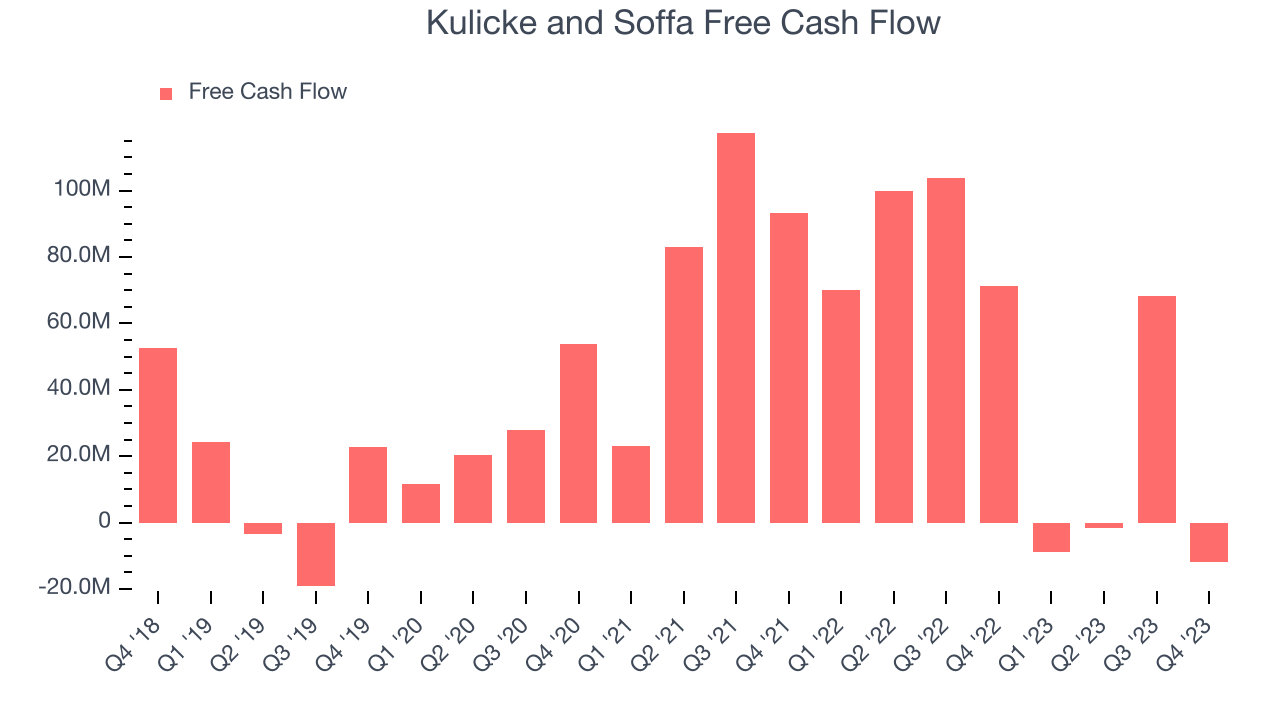
As you can see above, Kulicke and Soffa produced free cash flow of just $46 million in the last year, resulting in a measly 5.2% free cash flow margin. Kulicke and Soffa will need to improve its free cash flow conversion if it wants to stay competitive.
Return on Invested Capital (ROIC)
EPS and free cash flow tell us whether a company's revenue growth was profitable. But was it capital-efficient? If two companies had equal growth, we’d prefer the one with lower reinvestment requirements.
Enter ROIC, a metric showing how much operating profit a company generates relative to its invested capital (debt and equity). ROIC not only gauges the ability to grow profits but also a management team's ability to allocate limited resources.
Kulicke and Soffa's five-year average ROIC was 56.5%, placing it among the best semiconductor companies. Just as you’d like your investment dollars to generate returns, Kulicke and Soffa's invested capital has produced excellent profits.
The trend in its ROIC, however, is often what surprises the market and drives the stock price. Over the last two years, Kulicke and Soffa's ROIC has averaged a 15.8 percentage point increase each year. Kulicke and Soffa has historically shown the ability to generate good returns, and its rising ROIC is a great sign. It could suggest its competitive advantage or profitable investment opportunities are growing.
Key Takeaways from Kulicke and Soffa's Q1 Results
We were impressed by how Kulicke and Soffa blew past analysts' EPS expectations this quarter. But that's where the good news ends. Its free cash flow fell short of estimates, and its revenue and EPS guidance for next quarter significantly missed analysts' projections. Furthermore, its operating margin shrunk. The company noted that continued weakness in its automotive and power end markets negatively impacted demand-commentary which is consistent with its Q4 2023 remarks. Lastly, the management team is expecting its semiconductor unit growth to normalize later this year. Overall, this was a mixed quarter for Kulicke and Soffa. The company is down 2.2% on the results and currently trades at $49.19 per share.
Is Now The Time?
Kulicke and Soffa may have had a bad quarter, but investors should also consider its valuation and business qualities when assessing the investment opportunity.
We think Kulicke and Soffa is a solid business. We'd expect growth rates to moderate from here, but its revenue growth has been strong over the last three years. And while its operating margins reveal subpar cost controls compared to other semiconductor businesses, the good news is its stellar ROIC suggests it has been a well-run company historically.
Kulicke and Soffa's price-to-earnings ratio based on the next 12 months is 22.2x. There are definitely things to like about Kulicke and Soffa and looking at the semiconductors landscape right now, it seems that the company trades at a pretty interesting price point.
Wall Street analysts covering the company had a one-year price target of $58.3 per share right before these results (compared to the current share price of $49.19), implying they saw upside in buying Kulicke and Soffa in the short term.
To get the best start with StockStory check out our most recent Stock picks, and then sign up to our earnings alerts by adding companies to your watchlist here. We typically have the quarterly earnings results analyzed within seconds of the data being released, and especially for the companies reporting pre-market, this often gives investors the chance to react to the results before the market has fully absorbed the information.
